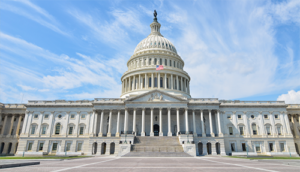Engaging members, advocates, and lawmakers is challenging for advocacy professionals even at the best of times. During an election year, the extra noise means securing the eyes and ears of important stakeholders can feel like an uphill battle.
Amid the wave of election activity, it can be difficult to cut through that noise and confidently deliver your message to your audience, but that’s exactly what the best advocacy professionals do. Top advocacy pros embrace the election year activity and use it to their advantage.
This election-year playbook will provide the best tips, tools, and strategies to move your issues forward and strengthen critical relationships amid the election fanfare.
 Table of Contents
Table of Contents
- Expert Advice for Election-Year Advocacy
- How to Advance Your Issues During Election Years
- How to Create a Successful Election-Year Advocacy Strategy
- How to Drive Election-Year Social Media Campaigns
- Harness the Power of Advocate-Generated Content
- Expert Tips to Engage Supporters During Election Years
- Data-Driven Approaches for Writing to Congress
- Advocacy Comms Best Practices for Success
- Succeed With Your Get Out the Vote Campaign
- Ensure Your Advocacy Campaigns Are Inclusive
Expert Advice for Election-Year Advocacy
The commotion of election campaigns can be tough to penetrate, but rather than trying to stand taller and yell louder than the other voices, try to ride the wave of that campaign momentum.
On our recent webinar about election-year advocacy advice, Rob Burgess, chief strategist at Connector Labs, spoke about swimming with the current instead of going against the grain during election season. By pushing the importance of an issue to candidates’ offices, Burgess tries to get political candidates to bring his clients’ issues into their campaigns.
“Our goal is to have these champions actually carry the water during the campaign for us,” says Burgess. “We don’t want to change our messaging to help them. We want them to change their messaging to help us.”
Other key takeaways from the webinar include:
- Temper expectations during election years and line up champions for the long-term
- Use polls to gauge the political environment (and even conduct your own polls!)
- Election years are great times for build coalitions
- Don’t become farsighted — election day is important but set incremental goals that focus on the now
- Use the noise and extra media attention to your advantage
 How to Advance Your Issues During Election Years
How to Advance Your Issues During Election Years
While advocacy professionals and the organizations they serve should have tempered expectations in this busy year, that doesn’t mean issues should be put on ice until the election passes.
There is a lot of productive work that advocacy professionals can do in an election year, it just requires a slight change of tactics. Here are four ways to advance your issues during election years.
1. Leverage petitions to show the strength of your base
While petitions rarely include many personal messages, they serve an important purpose: showing at a glance how numerous your supporters are. All of this helps grow your audience and strengthen your group of supporters.
2. Clearly show your organization’s footprint
You know the importance you bring to the communities that you work with, but do the candidates running for office understand how your organization helps their constituents?
Showing your contributions to their districts will help get candidates’ attention.
3. Contact legislators and personalize the issue
Volume is still a key component to getting a lawmaker’s attention, but if you want a lawmaker to connect with their constituents’ issues, personalized messages detailing an issue’s impact on a person or community are particularly effective.
4. Publish lawmaker scorecards so they’re on the record
Legislators often campaign for reelection on the work they’ve done and causes they’ve supported. Scorecards are an easy way to show if their claims hold up. Knowing that the public is closely examining their voting records means lawmakers are apt to align with their constituents’ positions.
 How to Create a Successful Election-Year Advocacy Strategy
How to Create a Successful Election-Year Advocacy Strategy
Election activity is fast-paced and many different issues will catch a piece of the spotlight. To make sure that your issues get attention, you need to have the right approach. Here are three tips to create a strong election-year strategy that shines a bright light on the issues affecting your supporters.
1. Tell Compelling Stories
Compelling stories from members and advocates are critical during an election year when you want your issues to stand out from the crowd. These stories can cut through the election noise and grab your audience’s attention.
2. Leverage Coalitions
An election year is a great time to find organizations doing similar work, join a coalition, or strengthen existing relationships. You can work together to tailor your message, keep each other informed on important issues or relevant election news, and have a network of allies for support in advocacy projects and campaigns.
3. Execute Standout Meetings
Nothing goes quite as far as a meeting with lawmakers. Keep in mind, however, that some of your advocates may not have experience meeting with lawmakers. Ensure advocates are thoroughly briefed on talking points and equipped with one-pagers before meeting with elected officials.
 How to Drive Election-Year Social Media Campaigns
How to Drive Election-Year Social Media Campaigns
During election season, certain social media channels can become saturated with political messages, particularly Facebook.
While Facebook is the best platform overall for advocacy organizations, each social media channel has its own merits. Here’s how to use the different social media platforms for better digital advocacy this election year.
Facebook remains the most influential platform for advocacy, accounting for 75.9 percent of social traffic to advocacy Action Centers, according to our annual Advocacy Benchmark Report. The audience for Facebook tends to skew a little older, so it can be good for reaching a Gen X or Boomer demographic who may not have a big social presence elsewhere.
X (formerly Twitter)
X remains a leading platform for advocacy and political outreach. It’s great for sharing quick information via snappy taglines. Most importantly, X is the platform that nearly all elected officials are on. When you want to make posts you know political leaders will see, this is the platform to use.
Instagram is all about eye-catching images and videos. Its visual nature makes it an excellent platform for sharing updates about your work or celebrating successes. Instagram also allows you to livestream (as does Facebook), which can be a great way to foster engagement.
TikTok
TikTok is today’s ascendant social platform, with a major influence on culture — especially youth culture. If you’re trying to connect with a younger audience, you want to be active on TikTok. It favors those who know how to capitalize on viral trends.
 Harness the Power of Advocate-Generated Content
Harness the Power of Advocate-Generated Content
While you focus on producing content for social media, don’t overlook the content that your advocates create. This might be organically created content that you amplify, or a targeted collaboration with advocates that you curate. Either way, advocate-generated content can be a powerful impact driver.
Find Your Advocacy Partners
If you are recruiting advocates for a video series or an in-person speech, you can look through your records of past advocate activity to find people particularly enthusiastic about your cause. For example, VoterVoice users can consult their advocate leaderboards to find their most engaged supporters.
Remember, if advocates are going to deliver an authentic message, their passion needs to be authentic, too.
Collaborate with Advocates
Certain advocacy activities require training, so don’t hesitate to provide advocates with resources or an advocacy curriculum. Even though you have the final say in how you run your campaign, it’s a good idea for an advocate to have the final say in their message.
Share Organically Created Content
You may find social media posts about your cause that were made organically. These are impossible to plan for, but it’s important to capitalize on them by re-sharing.
“When an organization re-shares that user-generated content, it not only amplifies the message, but also helps people feel seen, heard, and acknowledged,” says Jennifer Pullinger, communications practitioner and social media strategist.
Expert Tips to Engage Supporters During Election Years
It’s challenging to reach your supporters in an election year because of the extra communications they are likely to receive. This makes it crucial that every message you send is important and keeps your advocates engaged, rather than just crowding their inboxes.
Data & Action-Driven Advocacy
Innovative advocacy organizations rely on a data science approach to find state and local races that will impact their issues. Caroline Spears, head of Climate Cabinet, tracks the voting records of more than 5,000 elected officials across the country and supports the officials making the biggest impact. “We have folks who aren’t on CNN all the time, but if you look at the climate impact, it’s pretty impressive,” she says.
In addition to gathering data, technology can help your organization measure its performance by tracking email opening rates, website hits, and how long people stay on your site, which can gauge engagement.
Keeping Advocates Engaged
One of the hardest things about driving engagement and mobilizing advocates is that politics in the U.S. can seem to move at a glacial pace, which can make people lose focus. Elections are an opportunity to drive interest since advocates can see change happening.
It’s important to communicate your wins to advocates and keep them updated on important issues. Regular check-ins, like a monthly newsletter or quarterly town hall meeting, ensure advocates stay connected and energized. It’s also critical to thank advocates often for donating their time and effort.
Focus Your Efforts
A big part of using data to make advocacy decisions is figuring out where you can make the most impact. For Spears, that’s at the state and local level, where the impact of individual voters and small donations is magnified.
Concurrently, federal elections can be big opportunities for advocates: the media may be more interested in covering advocacy, other organizations will be ramping up their work and interested in collaborating, and people may be more willing to volunteer their time for phone banking, canvassing, or other activities.
 Data-Driven Approaches for Writing to Congress
Data-Driven Approaches for Writing to Congress
In an election year, advocacy professionals have a lot on their plate and resources can be stretched pretty thin. Likewise, supporters are probably receiving more political messages than normal. This raises the importance of targeted messaging.
When it comes to writing to Congress, data can help you target the supporters who are most likely to send an email or write a letter.
The people who write to Congress are most likely to: be older than 65, be white, have an advanced degree, be retired, earn more than $70k/year, and be a member of a political group.
Depending on the issue, however, these demographics can change. Supporters are more likely to reach out to Congress over issues that are important to them. Analyzing data on your supporters can help you find your ideal candidates to send emails to Congress.
VoterVoice lets supporters send a pre-written message with the option to add their own thoughts and personal stories.
Advocacy Comms Best Practices for Success
When it comes to communicating with your supporters during this election year, personalized messages are the ones that are most likely to grab their attention.
Access to the right data can help you be more strategic, efficient, and effective. Data drives everything from helping you compose messages and increase open rates to delivering powerful insights when reporting results.
Here are the 5 best practices for advocacy communications this election year.
Segment Smartly
Using data is critical to target your email messages to the right inboxes. You will engage supporters more effectively by narrowing your recipient list to contacts with tags relevant to the campaign. VoterVoice does this with the automatic topic tagging feature.
Keep Your Message Simple
Short and clear messaging works best. For calls to action, be specific in asking for help (“Call your representative,” not just “Speak out”). Make a case for why supporters must take action now. Factors like subject line, message length, use of acronyms, number of links, and send time all matter.
Benchmark Your Email Performance
The best way to gauge the effectiveness of your communications is by looking at how your emails compare to outreach focused on similar themes. VoterVoice Insights shows how your campaigns stack up against industry peers when it comes to open, action, unsubscribe, and email failure rates. Best of all, it gives you tips on how to improve your results.
Monitor Activity By Geographic Area
Knowing in which locations your advocates are most engaged helps you hone in on that support and leverage it to make your campaign more effective. It also allows you to strategically plan outreach and craft different messaging for more and less active audiences.

Succeed With Your Get Out the Vote Campaign
As election day approaches, you want to be sure that your supporters know exactly what they need to do to cast a ballot. Here are three expert tips to maximize engagement for your GOTV campaign.
1. Make it Easy
You want to make it as easy as possible for your advocates to participate in the political process. Make sure to have a central place where people can get all the information you need. VoterVoice’s Action Center allows you to help your supporters register to vote, find who their candidates are, what their local requirements and deadlines are for absentee or early voting, and what is at stake for your key issues.
2. Designate a Day
Set a date for a big early voting push or for people to register to vote. Make it an event for your organization where people engage in the political process together and feel part of your community.
3. Host Virtual Events
Continue building that sense of community by hosting virtual or hybrid events to make participation more accessible. Consider hosting a debate, town hall watch party and discussion, or a webinar about how your issues play out in the upcoming election.
Ensure Your Advocacy Campaigns Are Inclusive
Ignoring inclusion means you risk inadvertently excluding large swaths of potential supporters — and having a less successful campaign as a result.
Central to inclusion is a commitment to featuring diverse groups of people and elevating their voices. Making space for people from underrepresented groups (including marginalized races, religions, ethnic backgrounds, sexual identities, etc.) sends the message that every type of supporter is welcome in your campaign.
Here are some tips to make your advocacy campaigns more inclusive and have a bigger impact during the election season.
Language
“The first tip is using plain, clear, and simple language, even for experts,” says Stacie Manger, director of digital communications at the American Forest and Paper Association. “The average reading level across the U.S. is 5th to 6th grade … If you’re using industry jargon, acronyms, and writing complex sentences, your message will be lost.”
Alt Text
When creating visual content, make sure all images have alt text, which is text that can be read by screenreading software so visually impaired people understand what’s being shown.
Captions
Closed captions should be available for all videos — not just computer-generated captions, but captions checked for accuracy by a human. This is necessary for people who are deaf and hard of hearing, and it can be helpful for people with attention issues.
In-Person Accommodations
Physical accessibility should of course be considered when hosting in-person events. Your venue should have ramps or elevators, aisles wide enough for a wheelchair, accessible seating, and other accessibility considerations. Try to have a sign language interpreter or closed captioning available if any speeches or talks are planned.
Set Yourself Up For Success This Election Year
VoterVoice is the ultimate companion for your advocacy efforts this election season. From the one-stop action center to data-based insights and AI capabilities, VoterVoice organizes and optimizes your advocacy efforts, ensuring that you harness the election momentum and hit the ground running once the election dust settles.


